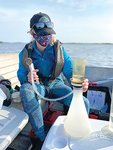Scalloping season began July 1 on the Nature Coast. As people flock to the state’s west coast in search of the prized shellfish...
Join our family of readers for as little as $5 per month and support local, unbiased journalism.
Already have an account? Log in to continue. Otherwise, follow the link below to join.
Please log in to continue |


GAINESVILLE — Scalloping season began July 1 on the Nature Coast. As people flock to the state’s west coast in search of the prized shellfish, scientists with the University of Florida will also be in the water, though instead of collecting scallops they’ll be after data points.
“The data they collect will provide insight into the health of the ecosystem in which scallops and many other species live,” said Savanna Barry, regional specialized agent with UF/IFAS Extension Florida Sea Grant based at the Nature Coast Biological Station in Cedar Key.
With support from the Florida Department of Environmental Protection and The Pew Charitable Trusts, over the next several months UF/IFAS scientists and graduate students will sample water and seagrass in the recently created Nature Coast Aquatic Preserve, located off Citrus, Hernando and Pasco Counties. More than 400,000 acres, the preserve supports one of the largest seagrass beds in the country as well as other important marine habitats such as saltmarsh and oyster reefs.
“Our seagrass beds are what really sets this area apart, and without our estuaries and seagrass, the fishery can’t thrive. They are the building blocks,” said Captain Dan Clymer, a fishing guide based in Crystal River, Florida.
There are more than 40 aquatic preserves in Florida, Barry said. These natural resources are sensitive to changes in nutrients, light levels and seagrass growth. But these changes happen over time, so scientists take regular samples to understand larger trends that may affect the region.
“Over the next several months, we’ll be looking at water quality at 90 monitoring stations spread across nine different river systems in the area,” Barry said.
With each water sample, the scientists measure nutrient levels and how much light passes through the water. The more nutrients, the better the environment for algae, which in turn can block light from reaching the ocean floor and potentially harm the seagrass growing there. Water samples are analyzed by the UF/IFAS LAKEWATCH Lab.
Over the summer, in addition to monitoring water quality, the team will also sample seagrass at 100 stations across four local river systems.
“Seagrass beds are important habitat for shellfish, fish, manatees and other species, making them a good barometer for the overall ecological health of the area,” said Laura Reynolds, an assistant professor in the soil and water sciences department and co-principal investigator for the project with Barry.
“When we take seagrass samples, we are measuring its height, how much area it covers, species diversity, sediment conditions and the animals living there,” Barry said.
Graduate students in the UF/IFAS College of Agricultural and Life Sciences will assist with both types of sampling.
“It’s a great hands-on learning experience and puts their own research into a larger context,” Reynolds said.
All the data collected are entered in a public database that environmental managers and scientists can access. Alongside the data collection effort, research associate and UF/IFAS CALS alumna Hannah Brown and Florida Sea Grant Geographic Information System specialist Corina Guevara will draft a management plan for the preserve with guidance from the Florida Department of Environmental Protection’s Office of Resilience and Coastal Protection which oversees the state’s aquatic preserve network
Following that, the UF/IFAS team will hold a series of community workshops with local stakeholders to help identify and refine priority issues the plan will address. The plan’s goal is to maintain the preserve’s biological, scientific and aesthetic value for future generations to enjoy while allowing and improving access for activities such as boating, scalloping and fishing.
For the last 26 years, Captain John Bazo has been helping anglers and scallop divers enjoy the area that is now the Nature Coast Aquatic Preserve.
“This effort is of interest to all of us in the fishing guide community,” said Bazo, a fishing guide based in Homosassa, Florida. “I know there are areas in Florida where the seagrass is disappearing. We don’t want to lose it here, and that’s why we want to be involved,” he said.
Past water quality monitoring efforts in the area were led by Tom Frazer, then director of the UF/IFAS School of Natural Resources and Environment who went on to serve as Florida’s first chief science officer. Frazer is now the dean of the College of Marine Science at the University of South Florida.